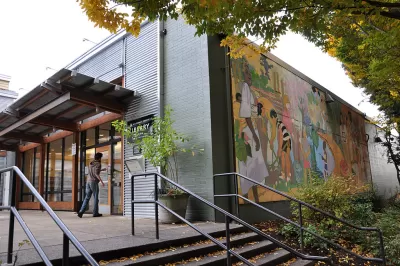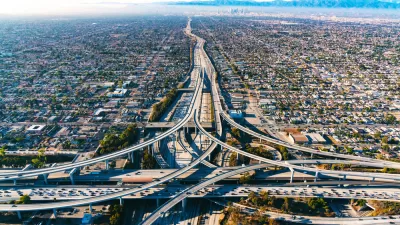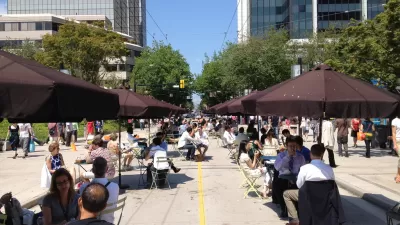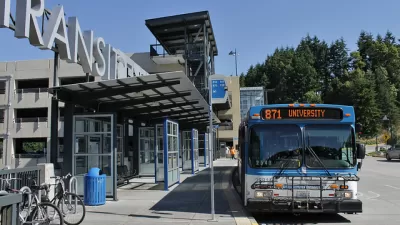Urban sustainability efforts have historically failed to advance all three E’s of sustainability: environmental action, economic development, and equity. However, a movement is underway to put equity—the oft-ignored E—at the forefront.

In the vacuum of national policy leadership and international consensus on climate action, cities around the world are ramping up local-level climate initiatives. The imperative for urban planning and policy action on climate is undeniable. The majority of people around the world live in cities, cities account for a significant amount of global greenhouse gas emissions, and cities are particularly vulnerable to the impacts of climate change. For local climate action planning efforts to have maximum positive impact, they must prioritize all three E's of sustainability: environmental action, economic development, and social equity.
For an example of how cities can advance the three E's in a meaningful way, look to the Portland Clean Energy Initiative. Van Jones recently called it the "most important ballot initiative in the country."
Sure, Portland, Oregon has long been renowned as a "sustainable city." But like in other cities, Portland's green sustainability successes have been inequitably distributed (see Goodling, Green & MicClintock, 2015). Meanwhile, the city's residents of color experience significant disparities relative to white people, documented in a series of “unsettling profiles” by the Coalition of Communities of Color. Low-income residents are being displaced from the city via intense gentrification. In short, Portland is more of a case study in unbalanced sustainability than in a three-pronged approach.
But a measure on the ballot this November signals an important change in the sustainability movement in Portland. The Portland Clean Energy Initiative measure thoughtfully advances all three E’s of sustainability and climate action.
The Portland Clean Energy Initiative is expected to raise over $30 million annually in new revenue, up to 75 percent of which will fund energy efficiency upgrades, home weatherization (lowering utility bills for renters and homeowners), community-scale renewable energy, tree planting, and urban greening, all while prioritizing Portland’s most vulnerable neighborhoods. Another 25 percent of the revenue generated by the initiative is intended for green job training that prioritizes economically disadvantaged workers, including the chronically underemployed, communities of color, people with disabilities, and women.
The new revenue will come from a one percent surcharge on the Portland business license for mega-retail businesses only—those with revenue above $1 billion per year and above $500,000 annually within city limits. Proponents emphasize that there is no evidence to suggest this surcharge will be passed on to consumers. To assuage concern about regressive impacts, revenue from groceries, medicine, and health care services are exempted.
The call for a three-pronged approach in municipal-scale sustainability like this is not new. In 1996, one of the most cited planning articles of the past century called for urban planners to focus not just on "green cities and growing cities" but also on "just cities." Likewise, Julian Agyeman, Robert Bullard, and Bob Evans called on urban leaders in 2003 to adopt the concept of just sustainabilities, or the need to ensure a "better quality of life for all, now, and into the future, in a just and equitable manner, whilst living within the limits of supporting ecosystems."
While sustainability and the three E's have become a defining principle of good urban planning, actual on-the-ground practice has often fallen short. Sustainability efforts have often heavily favored one E, economic growth, at the expense of environmental protection or improvements in social equity. In a Planetizen feature in 2007, planning scholar Dr. Michael Gunder warned that "Planning practitioners need to carefully reflect on their role... Otherwise, planners may continue to conflate the triple-bottom-line of environment, social equity, and economy together in a manner that risks both the environment and social equity in the name of sustainable wealth creation for the dominant minority profiting from competitive globalization." Likewise, other sustainability scholars (e.g., Pearsall and Pierce, 2010; Finn and McCormack, 2011) have examined municipal sustainability and climate action plans and found them weak in terms of attention to equitable economic development and environmental justice.
Meanwhile, historically disadvantaged people continue to experience the cumulative impacts of environmental, racial, and socioeconomic burdens. Nationwide, low-income Latino and African American households proportionally spend an average of three times more of their salary on utilities than wealthy Americans do, according to a 2016 American Council for an Energy-Efficient Economy study. Hundreds of studies on environmental justice document how poor populations and people of color are more likely to live near hazardous waste sites and sources of air pollution, have access to fewer environmental benefits such as parks, experience less stringent enforcement of environmental regulations, and are excluded from environmental decision-making. Consequently, they experience worse health outcomes and are more vulnerable to the effects of climate change, like intense heat events and storms.
The Portland Clean Energy Initiative is a true collaboration among civil rights and social justice organizations, including the Asian and Pacific Islander Network of Oregon, the Coalition of Communities of Color, the Native American Youth and Family Center, and the NAACP Portland chapter, as well as more environmentally focused organizations like the Audubon Society of Portland, the Oregon chapter of the Sierra Club, and Columbia Riverkeeper, and environmental justice groups that have long bridged the two movements, like OPAL Environmental Justice Portland and Verde. As Jenny Lee, advocacy director at the Coalition of Communities of Color said in an interview with Grist, "It’s groundbreaking… It’s the first environmental or climate initiative, as far as we know, that’s been led by organizations of color in Oregon...It’s a very clear statement that we are here, we are leading on policy, and we are also building political power."
Portland voters will have a chance to vote YES on Portland Clean Energy Initiative this November. Regardless, the initiative is an example for planners and urban sustainability policy makers that embraces the full three prongs of sustainability and there are some valuable insights other cities can glean: 1) forge alliances among civil rights/social justice and environmental organizations; 2) prioritize investments in neighborhoods, communities, and individuals that have historically experienced environmental injustices; 3) ensure that green jobs will pay living wages and are targeted to economically disadvantaged workers; 4) counter gentrification; and (5) seek funding from the economic elite.
Find out more about the Portland Clean Energy Initiative here.
Megan Horst, PhD, AICP, is an assistant professor in the Toulan School of Urban Studies and Planning at Portland State University, where she teaches about and researches urban planning and environmental justice, especially food justice. More about Dr. Horst here.

Maui's Vacation Rental Debate Turns Ugly
Verbal attacks, misinformation campaigns and fistfights plague a high-stakes debate to convert thousands of vacation rentals into long-term housing.

Planetizen Federal Action Tracker
A weekly monitor of how Trump’s orders and actions are impacting planners and planning in America.

In Urban Planning, AI Prompting Could be the New Design Thinking
Creativity has long been key to great urban design. What if we see AI as our new creative partner?

King County Supportive Housing Program Offers Hope for Unhoused Residents
The county is taking a ‘Housing First’ approach that prioritizes getting people into housing, then offering wraparound supportive services.

Researchers Use AI to Get Clearer Picture of US Housing
Analysts are using artificial intelligence to supercharge their research by allowing them to comb through data faster. Though these AI tools can be error prone, they save time and housing researchers are optimistic about the future.

Making Shared Micromobility More Inclusive
Cities and shared mobility system operators can do more to include people with disabilities in planning and operations, per a new report.
Urban Design for Planners 1: Software Tools
This six-course series explores essential urban design concepts using open source software and equips planners with the tools they need to participate fully in the urban design process.
Planning for Universal Design
Learn the tools for implementing Universal Design in planning regulations.
planning NEXT
Appalachian Highlands Housing Partners
Mpact (founded as Rail~Volution)
City of Camden Redevelopment Agency
City of Astoria
City of Portland
City of Laramie





























